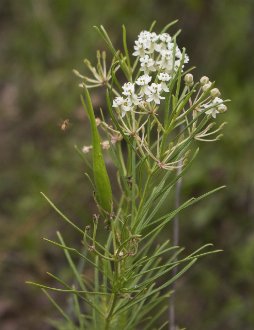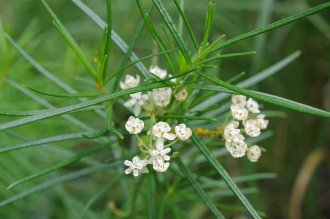Whorled Milkweed (Asclepias verticillata L.)
Also known as horsetail milkweed.
↑Summary
A small milkweed with very narrow leaves in a whorl around the stem, a pioneer species of dry, barren sites.
↑Range - Expand
| Legend | Color |
| Native | |
| Native or Not Present |
This tentative map is based on our own research. It may have limited data on Canada and/or Mexico, and there is some subjectivity in our assignment of plants as introduced vs. expanded. Read more in this blog post.
Although this plant occurs somewhere in each of these regions, it may only occur in a small part of some or all of them.
↑Habitat
Whorled milkweed is a pioneer species of dry, open areas with infertile soil. Habitats include upland prairies, especially with sand and gravel, savannas, rocky openings in upland forests, limestone barrens, and rocky bluffs. Also found in anthropogenic habitats including pastures, abandoned fields, grassy slopes along roadsides, and waste ground.
Usually limited to sites where recent disturbance has removed the vegetation. Tolerates mesic to dry conditions in a range of soil textures including sand, gravel, loam, and clay-loam, but limited to infertile soils where there is less competition from other plants. Prefers full sun but can sometimes be found on sites with only partial sunlight if there is little ground-level competition from other vegetation.
This species becomes more widespread in the central portion of its range, where rainfall is low enough that this plant has more of a competetive edge. In the east, where rainfall is higher, other, more broadleaf Asclepias species including butterfly milkweed (Asclepias tuberosa) and common milkweed (Asclepias syriaca) are more competitive on most sites and this species becomes rare and restricted to the driest soils such as coarse sands and rock.
↑Life Cycle
This species is a rhizomatous perennial like other milkweeds. It forms colonies on suitable sites.
↑Uses
This species is occasionally grown in gardens, where it is valued for its delicate foliage, small maximum size, drought tolerance, and deer resistance. It is relatively easy to grow in gardens and can survive in richer soils than it would occur on in the wild, if competing plants are kept away from it.
↑Links & External Resources
• Asclepias verticillata (Whorled Milkweed) | Illinois Wildflowers (About This Site)
• Asclepias verticillata (Whorled Milkweed) | USDA PLANTS Database (About This Site)
• Asclepias verticillata | Go Botany (About This Site)
• Whorled Milkweed | iNaturalist (About This Site)
• Asclepias verticillata (Whorled Milkweed) | Missouri Botanical Garden Plant Finder (About This Site)
• Asclepias verticillata | Biota of North America Project (BONAP) (About This Site)
• Asclepias verticillata | NatureServe Explorer (About This Site)
• Asclepias verticillata | Missouri Plants (About This Site)
• Whorled Milkweed | Maryland Biodiversity Project (About This Site)
• Asclepias verticillata (Whorled Milkweed) | Minnesota Wildflowers (About This Site)
• Asclepias verticillata L. (Whorled Milkweed) | Digital Atlas of the Virginia Flora (About This Site)






